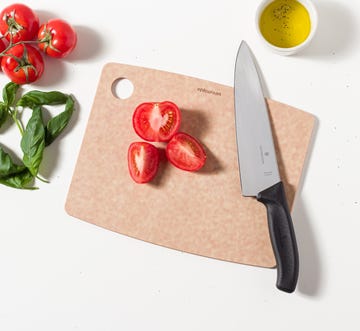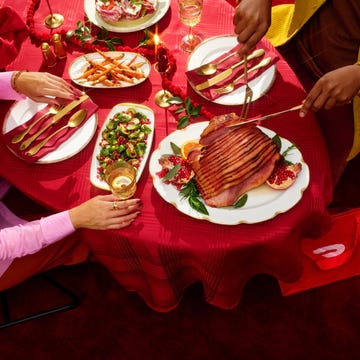If you’ve ever found yourself bristling when it comes to the confusing terminology regarding Scotch whisky, you’re not alone. That’s why we partnered with Johnnie Walker to address the most commonly asked questions about the spirit, from how it’s made to the best ways to enjoy it, so the next time you pour yourself a dram or mix up a cocktail, you'll have an insider's edge for optimal enjoyment.
In order to be called Scotch whisky, Scotch must actually be made in Scotland. That’s right, Scotch whisky (no “e”) originated in Scotland, just as bourbon originated in Kentucky’s Bourbon County. Although bourbon can now technically be produced in areas that fall outside of Bourbon County, Scotch still must come from Scotland. Otherwise, it’s whisky (which, if you’re in the U.S. or Ireland, is more commonly spelled “whiskey”).
The process happens in a space called a malting house (where grain is converted into malt). There, grains and yeast are combined with water and germinated. Peat is then burned to dry the grains. This adds a smokiness to the character. The master distiller can choose how much smoke to add or withhold, which is why some Scotch whiskies can present as “peaty” aka smokey, and some as not peaty at all.
Then, water is added to the malted barley—this part is known as mashing. The water is later drained from the mash, or spent grains, and yeast is added, which begins the process of fermentation. Following fermentation, the low-alcohol mixture is distilled, boosting its alcohol content and turning it into a spirit. Large batches are distilled in column stills, while small batches are distilled in pot stills, which produce far less volume.
Scotch whiskies undergo the last step of their journey, lying in wait in oak casks. Spirits must be aged for a minimum of three years in oak prior to release, although many distillers hold them far longer, a designation that is often clarified on the bottle’s label. Johnnie Walker Black Label, for instance, is aged for a minimum of 12 years.
American and European oaks are both used in maturation, and they impart varying taste profiles due to the different pore sizes and oils of the trees. The toast of the barrel, size of the barrel, and newness of the barrel also impact how much flavor it will impart on the spirit within it. Scotch whiskies that are blended are done so following maturation.
Single Malt Scotch
The term “single malt Scotch” refers to Scotch whisky that’s been produced from a single distillery, and not from one harvest or barrel. Produced entirely from malted barley, as opposed to from a mix of barley and other grains, single malt Scotch is often highly regarded by serious Scotch drinkers. Single malt Scotch also must be produced in Scotland, or it cannot be called Scotch.
Blended Scotch
Blended Scotch is simply a blend of Scotch whiskies—they can be both malted barley whiskies and/or grain whiskies from more than one distillery. These account for most of the Scotch whiskies produced. Like its cousin, single malt Scotch, blended Scotch must be produced in Scotland to be called Scotch.
High Rye
High rye is a distinction often granted to bourbon, but it can be used to describe Scotch too. It means that, in addition to malted barley, the grain that will eventually become mash includes a high percentage of rye, which is known for its spicy qualities. Johnnie Walker High Rye, which is aged in American oak, is a great example of this style. The distinctive Scotch is both sweet and spicy, with a finish that lingers. Learn more about Johnnie Walker High Rye here.
Aged Scotch
Although Scotch must be aged for a minimum of three years, the limit on aging is seemingly endless. Unlike wine, whisky does not age in the bottle, nor does it improve in the bottle, but it can change—and improve—in the cask. Aging in a cask lends a smoothness and finesse to these whiskies. Scotches can be aged for a handful of years or for decades; one common aging timeframe is 12 years. Johnnie Walker Black Label, for example, is aged for a minimum of 12 years. Made from a blend of single malt and grain whiskies, the Black Label is a creamy, toffee-driven Scotch that drinks well both neat and on the rocks. Of note: aged Scotches do tend to be more expensive, as they take more time to produce, and therefore cannot be profited from as quickly or as easily. Learn more about Johnnie Walker Black Label here.
Other grains used
Some other grains that may be used in Scotch whisky include corn (which imparts a sweeter flavor and which is best known for its use in bourbon), wheat, rice, and millet. All grains contribute their own unique qualities, which is why it is up to the master distiller to decide which to include or exclude.
Scotch drinkers differ on this point, but Scotch can be consumed neat (no ice), on the rocks (over ice), or with a single ice cube, which many argue helps to express its aromatics. Enjoyed either as an aperitif or digestif, the spirit is meant to be sipped slowly, so that its virtues come to the foreground. You may notice notes of caramel from the oak; subtle hints of smoke from the peat; and, or a focused spiciness in the back of the palate.
Like a fine wine, Scotch whisky can be paired with food for a multi-layered experience. Rich, smoky foods pair naturally with Scotch whisky, as do foods with sweetness, creamy elements, and a backbone of spice. Check out these recipes and our suggestions for the ultimate Scotch pairing.































